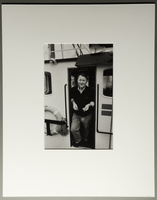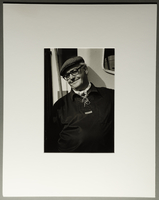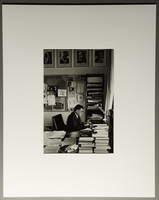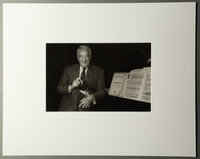Overview
- Brief Narrative
- Black and white photographic print taken by Judy Glickman in Gilleje, Denmark, in 1992 of Frede Svendsen, a Danish fisherman and rescuer. Frede used his boat to ferry Jews to Sweden. A rumor that a boat was leaving at 10pm resulted in hundreds trying to gain passage. There was a false alarm that the Gestapo was coming and as his boat left the dock, a man came running and at the last minute was pulled aboard. After the war, he returned to thank his rescuers. Germany occupied Denmark on April 9, 1940, but allowed the Danish government to retain control of domestic affairs. Jews were not molested and the German presence was limited. After the Germans invaded the Soviet Union in 1941 and began to face military setbacks, a Danish resistance movement developed. On August 29, 1943, the Germans declared martial law and began to address the Jewish problem. A mass deportation was scheduled for October 1. The plan was leaked and, the night before the action, Danish citizens organized a large scale rescue effort and ferried 7000 people, nearly all the Jews in Denmark, to neutral Sweden.
- Artwork Title
- Frede Svendsen
- Date
-
creation:
1992
- Geography
-
creation:
Denmark
- Credit Line
- United States Holocaust Memorial Museum Collection, Gift of Judith Ellis Glickman
- Contributor
-
Subject:
Frede Svendsen
Photographer: Judy E. Glickman
Subject: Judy E. Glickman
- Biography
-
Frede Svendsen was a Danish fisherman from Gilleleje, Denmark. The Germans occupied Denmark on April 9, 1940, but permitted the Danish government to retain control of domestic affairs. In October 1943, information that the Germans were prepared to begin the deportation of all the Jews in Denmark to concentration camps was leaked. Ordinary Danish citizens and resistance groups organized rescue efforts to hide and transport Jews to Sweden. Gilleleje was a large fishing harbor on the northernmost part of Zealand, Denmark (Zeeland, Netherlands) with train connections to Copenhagen. The local fishermen helped 1500 Danish Jews escape to Sweden. Frede, due to a false alarm that the Gestapo was coming, rescued 180 Jews who had gathered at the port in response to a rumor that a boat was leaving at 10pm. As the boat departed, a man came running and, at the last minute, was pulled aboard; he returned after the war to thank his rescuers. The war ended on May 2, 1945, when Berlin fell to the Soviet army. Germany surrendered to the Allied Forces and withdrew from Denmark.
Judy Ellis Glickman is a photographer and the daughter of Dr. Irving Bennett and Louise Ellis. Her father was a noted CAlifornia pictorialist photographer in the 1930s and 1940s. She pursued photography at a young age and obtained a Bachelor of Arts degree in 1959 from the University of California at Los Angeles. She studied photography at UCLA from 1978-1985, the Maine Photographic Workshop from 1978-87, and the Portland School of Art from 1984-1985. Her grandparents emigrated to the United States at the turn of the 20th century, and her mother and grandmother in 1914. Though not a child of a Holocaust survivor, it was while visiting concentration camps in Poland in 1988 that she began to wonder how many unknown family members perished. During this trip, the work became more personal, real, and meaningful to her. She returns to Europe every year to visit and photograph Holocaust sites. She was asked by the Thanks to Scandinavia Foundation to create a photographic narrative documenting the Danish rescue effort. She has exhibited extensively and won numerous awards. Both her sons are rabbis. She is on the board of the Portland Museum of Art in Maine and is a fellow of the Royal Photographic Society in England.
Physical Details
- Classification
-
Photographs
- Category
-
Photographic prints
- Object Type
-
Portrait photography (lcsh)
- Physical Description
- Black and white gelatin silver photographic print, portrait orientation, medium shot, shot in direct light, depicting an older white male with short white hair wearing a black Breton cap, standing on a pier. His large, solid body faces the camera and his eyes are squinted against the sunlight. He is smiling slightly and there are deep lines around his mouth. He is wearing dirty coveralls over a plaid collared shirt under a gray V-neck sweater. Two figures and some boat masts are in the background. The print is attached to a top hinged mat board with photo corners on the backboard. Pencil stop lines are on the reverse of the window mat. Pencil stop lines are on the reverse of the window mat.
- Dimensions
- overall: Height: 17.000 inches (43.18 cm) | Width: 13.500 inches (34.29 cm)
pictorial area: Height: 9.500 inches (24.13 cm) | Width: 6.250 inches (15.875 cm) - Materials
- overall : mat board, gelatin silver print, pressure-sensitive tape, plastic, adhesive, graphite
Rights & Restrictions
- Conditions on Access
- No restrictions on access
- Conditions on Use
- Restrictions on use. Donor retains copyright for this collection.
Keywords & Subjects
- Topical Term
- Anti-Nazi movement--Denmark. Holocaust, Jewish (1939-1945)--Denmark. Righteous Gentiles in the Holocaust--Denmark--Pictorial works. World War, 1939-1945--Jews--Rescue--Denmark--Pictorial works. World War, 1939-1945--Underground movements--Denmark.
- Geographic Name
- Denmark--History--German occupation, 1940-1945.
Administrative Notes
- Legal Status
- Permanent Collection
- Provenance
- The photograph was donated to the United States Holocaust Memorial Museum in 2010 by Judith Ellis Glickman.
- Funding Note
- The cataloging of this artifact has been supported by a grant from the Conference on Jewish Material Claims Against Germany.
- Record last modified:
- 2024-04-29 07:54:15
- This page:
- https://collections.ushmm.org/search/catalog/irn41824
Download & Licensing
In-Person Research
- By Appointment
- Request 21 Days in Advance of Visit
- Plan a Research Visit
- Request to See This Object
Contact Us
Also in Judith Ellis Glickman collection
The collection consists of portrait photographs taken by Judith Ellis Glickman from 1992-1993 of eleven Danish citizens who rescued Jews in German occupied Denmark and a Jewish couple who were rescued through these efforts during the Holocaust.
Date: 1992-1993
Portrait photograph by Judy Glickman of founding member of Danish resistance
Object
Black and white photographic print taken by Judy Glickman in 1993 of Frode Jakobsen, a Danish resistance leader. Frode founded the largest underground rescue group, the Ringen [The Ring], and co-founded the Danish Freedom Council to coordinate the efforts of different resistance groups. Frode remained active in the resistance until Denmark was liberated in May 1945. Germany occupied Denmark on April 9, 1940, but allowed the Danish government to retain control of domestic affairs. Jews were not molested and the German presence was limited. After the Germans invaded the Soviet Union in 1941 and began to face military setbacks, a Danish resistance movement developed. On August 29, 1943, the Germans declared martial law and began to address the Jewish problem. A mass deportation was scheduled for October 1. The plan was leaked and Danish citizens organized a large scale rescue effort to hide the Jews and, by the eve of the deportation, had ferried 7000 people, nearly all the Jews in Denmark, to neutral Sweden.

Portrait photograph by Judy Glickman of Danish man, courier for resistance
Object
Black and white photographic print taken by Judy Glickman in 1992 of Mogens Kofod-Hansen, a courier for Jewish rescue operations in Denmark. Mogens traveled to Sweden to deliver vital information to the British military during World War II. Germany occupied Denmark on April 9, 1940, but allowed the Danish government to retain control of domestic affairs. Jews were not molested and the German presence was limited. After the Germans invaded the Soviet Union in 1941 and began to face military setbacks, a Danish resistance movement developed. On August 29, 1943, the Germans declared martial law and began to address the Jewish problem. A mass deportation was scheduled for October 1. The plan was leaked and Danish citizens organized a large scale rescue effort to hide the Jews and, by the eve of the deportation, had ferried 7000 people, nearly all the Jews in Denmark, to neutral Sweden.
Portrait photograph by Judy Glickman of female Danish rescuer
Object
Black and white photographic print taken by Judy Glickman of Karen Lykke Poulsen, a rescuer active in the Communist underground in Denmark. Karen arranged for hundreds of Jews to be safely sent from Zealand to Sweden. Germany occupied Denmark on April 9, 1940, but allowed the Danish government to retain control of domestic affairs. Jews were not molested and the German presence was limited. After the Germans invaded the Soviet Union in 1941 and began to face military setbacks, a Danish resistance movement developed. On August 29, 1943, the Germans declared martial law and began to address the Jewish problem. A mass deportation was scheduled for October 1. The plan was leaked and Danish citizens organized a large scale rescue effort to hide the Jews and, by the eve of the deportation, had ferried 7000 people, nearly all the Jews in Denmark, to neutral Sweden.
Portrait photograph by Judy Glickman of Danish resistance leader and intelligence officer
Object
Black and white photographic print taken by Judy Glickman in 1992 of Otto Blixenkrone-Moller, a leader in the Danish resistance and a member of the Danish Military Intelligence Service. Otto reported to the Allies and the Special Operations Executive and sustained a leg and hip wound in an attempted arrest by the Gestapo in 1945. Germany occupied Denmark on April 9, 1940, but allowed the Danish government to retain control of domestic affairs. Jews were not molested and the German presence was limited. After the Germans invaded the Soviet Union in 1941 and began to face military setbacks, a Danish resistance movement developed. On August 29, 1943, the Germans declared martial law and began to address the Jewish problem. A mass deportation was scheduled for October 1. The plan was leaked and Danish citizens organized a large scale rescue effort to hide the Jews and, by the eve of the deportation, had ferried 7000 people, nearly all the Jews in Denmark, to neutral Sweden.

Portrait photograph by Judy Glickman of Danish woman who rescued several 100 people
Object
Black and white photographic print taken by Judy Glickman in 1993 of Dr. Ebba Lund, a member of Holger Danske resistance group. College student Ebba was the export leader and organized daytime rescue operations. She was known as the Girl with the Red Cap, in reference to the hat she wore as a signal to Jews that she was their contact. She walked them to the boats, paid the fisherman, and with the cooperation of the Danish coast guard and German soldiers, made sure that they made it to neutral Sweden without incident. Ebba rescued between 500-800 Jews. Germany occupied Denmark on April 9, 1940, but allowed the Danish government to retain control of domestic affairs. Jews were not molested and the German presence was limited. After the Germans invaded the Soviet Union in 1941 and began to face military setbacks, a Danish resistance movement developed. On August 29, 1943, the Germans declared martial law and began to address the Jewish problem. A mass deportation was scheduled for October 1. The plan was leaked and Danish citizens organized a large scale rescue effort to hide the Jews and, by the eve of the deportation, had ferried 7000 people, nearly all the Jews in Denmark, to neutral Sweden.
Portrait photograph by Judy Glickman of a Danish man who organized rescue efforts
Object
Black and white photographic print taken by Judy Glickman in 1993 of Dr. Ole Secher, a Danish rescuer. As a medical student, Ole organized rescue efforts for Jews hiding at Bispebjerg hospital. Germany occupied Denmark on April 9, 1940, but allowed the Danish government to retain control of domestic affairs. Jews were not molested and the German presence was limited. After the Germans invaded the Soviet Union in 1941 and began to face military setbacks, a Danish resistance movement developed. On August 29, 1943, the Germans declared martial law and began to address the Jewish problem. A mass deportation was scheduled for October 1. The plan was leaked and Danish citizens organized a large scale rescue effort to hide the Jews and, by the eve of the deportation, had ferried 7000 people, nearly all the Jews in Denmark, to neutral Sweden.

Portrait photograph by Judy Glickman of man who rowed several groups of Jews to safety
Object
Black and white photographic print taken by Judy Glickman in Gilleje, Denmark, in 1992 of Karl Egon Petersen, a Danish rescuer. Karl hid 36 Jews in his apartment for a day. Later that night he participated in an escape, rowing people 6 at a time to safety, including some of those he had hidden in his home. On the last transport, 2 policemen boarded the boat, found the Jews, but permitted the rescue operation to continue. Germany occupied Denmark on April 9, 1940, but allowed the Danish government to retain control of domestic affairs. Jews were not molested and the German presence was limited. After the Germans invaded the Soviet Union in 1941 and began to face military setbacks, a Danish resistance movement developed. On August 29, 1943, the Germans declared martial law and began to address the Jewish problem. A mass deportation was scheduled for October 1. The plan was leaked and, the night before the action, Danish citizens organized a large scale rescue effort and ferried 7000 people, nearly all the Jews in Denmark, to neutral Sweden.

Portrait photograph by Judy Glickman of Danish fisherman who helped take Jews to safety
Object
Black and white photographic print taken by Judy Glickman in 1992 of Neils Sorenson, a Danish fisherman and rescuer. Neils and his father helped 2 people escape.They took them on their boat, covered them with nets, and left in the morning. German boats patrolled the waters and the fishing boat reached a blockade but was not stopped. They continued into the harbor and the Jews were lowered into a dinghy and pushed to safety. Neils and his father continued their rescue efforts. Germany occupied Denmark on April 9, 1940, but allowed the Danish government to retain control of domestic affairs. Jews were not molested and the German presence was limited. After the Germans invaded the Soviet Union in 1941 and began to face military setbacks, a Danish resistance movement developed. On August 29, 1943, the Germans declared martial law and began to address the Jewish problem. A mass deportation was scheduled for October 1. The plan was leaked and, the night before the action, Danish citizens organized a large scale rescue effort and ferried 7000 people, nearly all the Jews in Denmark, to neutral Sweden.
Portrait photograph by Judy Glickman of Danish fisherman who took Jews to safety across the Oresund
Object
Black and white photographic print taken by Judy Glickman in 1992 of Jens Moller, a Danish fisherman and rescuer. Jens met a large group of Jews at the train station and brought an old couple and young couple with twins home. Neighbors brought food and it was 3 days before Jens found a boat that could transport them. He continued to rescue Jews and ferried them across the Oresund to Sweden on his own boat. Germany occupied Denmark on April 9, 1940, but allowed the Danish government to retain control of domestic affairs. Jews were not molested and the German presence was limited. After the Germans invaded the Soviet Union in 1941 and began to face military setbacks, a Danish resistance movement developed. On August 29, 1943, the Germans declared martial law and began to address the Jewish problem. A mass deportation was scheduled for October 1. The plan was leaked and, the night before the action, Danish citizens organized a large scale rescue effort and ferried 7000 people, nearly all the Jews in Denmark, to neutral Sweden.

Portrait photograph by Judy Glickman of Danish fisherman who hid and ferried Jews to safety
Object
Black and white photographic print taken by Judy Glickman in 1992 of Jens Moller, a Danish fisherman and rescuer. Jens met a large group of Jews at the train station and brought an old couple and young couple with twins home. Neighbors brought food and it was 3 days before Jens found a boat that could transport them. He continued to rescue Jews and transport them on his own boat. Germany occupied Denmark on April 9, 1940, but allowed the Danish government to retain control of domestic affairs. Jews were not molested and the German presence was limited. After the Germans invaded the Soviet Union in 1941 and began to face military setbacks, a Danish resistance movement developed. On August 29, 1943, the Germans declared martial law and began to address the Jewish problem. A mass deportation was scheduled for October 1. The plan was leaked and, the night before the action, Danish citizens organized a large scale rescue effort and ferried 7000 people, nearly all the Jews in Denmark, to neutral Sweden.

Portrait photograph by Judy Glickman of Jewish man sitting rescued as a boy
Object
Black and white photographic print taken by Judy Glickman in 1992 of Herbert Pundik, a Jew rescued as a young man by Danish civilians. The day before the Germans began to deport Danish Jews to concentration camps, 16 year old Herbert was pulled out of school and sent home, warned by the principal that Jews were in danger. His family packed and fled, finding shelter with a couple for 2 nights, until they boarded a fishing boat and set off across the Sound. In 1945, he joined the Danish voluntary forces and returned to Denmark after liberation and finished high school. Germany occupied Denmark on April 9, 1940, but allowed the Danish government to retain control of domestic affairs. Jews were not molested and the German presence was limited. After the Germans invaded the Soviet Union in 1941 and began to face military setbacks, a Danish resistance movement developed. On August 29, 1943, the Germans declared martial law and began to address the Jewish problem. A mass deportation was scheduled for October 1. The plan was leaked and Danish citizens organized a large scale rescue effort to hide the Jews and, by the eve of the deportation, had ferried 7000 people, nearly all the Jews in Denmark, to neutral Sweden.

Portrait photograph by Judy Glickman of Jewish woman rescued by Danes
Object
Black and white photographic print taken by Judy Glickman in 1992 of Susse Pundik, a Danish Jew who escaped Denmark with her family. Resistance members organized the escape of 14 year old Susse, her parents, and maternal grandparents to a fishing village where they waited for a boat. As daylight approached, they were informed that there was not enough room for everyone. Susse and her parents boarded the boat and her grandparents followed in another soon after. Germany occupied Denmark on April 9, 1940, but allowed the Danish government to retain control of domestic affairs. Jews were not molested and the German presence was limited. After the Germans invaded the Soviet Union in 1941 and began to face military setbacks, a Danish resistance movement developed. On August 29, 1943, the Germans declared martial law and began to address the Jewish problem. A mass deportation was scheduled for October 1. The plan was leaked and Danish citizens organized a large scale rescue effort to hide the Jews and, by the eve of the deportation, had ferried 7000 people, nearly all the Jews in Denmark, to neutral Sweden.

Portrait photograph by Judy Glickman of a Jewish Danish refugee
Object
Black and white photographic print taken by Judy Glickman in 1992 of Victor Borge, a Danish humorist and pianist. Throughout the 1930s, Victor toured Europe; he played music and told anti-Nazi jokes. When the Germans invaded Denmark, Victor was performing in Sweden. He did not return to Denmark, but sailed from Finland on the USS American Legion, arriving in the United States on August 28, 1940. Germany occupied Denmark on April 9, 1940, but allowed the Danish government to retain control of domestic affairs. Jews were not molested and the German presence was limited. After the Germans invaded the Soviet Union in 1941 and began to face military setbacks, a Danish resistance movement developed. On August 29, 1943, the Germans declared martial law and began to address the Jewish problem. A mass deportation was scheduled for October 1. The plan was leaked and Danish citizens organized a large scale rescue effort to hide the Jews and, by the eve of the deportation, had ferried 7000 people, nearly all the Jews in Denmark, to neutral Sweden.



